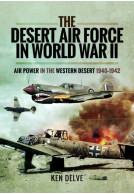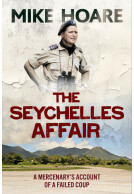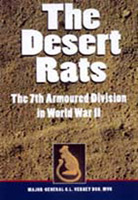How the RAF and USAAF Beat the Luftwaffe (Hardback)

Pages: 224
Illustrations: 16 pages of b/w illustrations
ISBN: 9781784383824
Published: 24th March 2021
(click here for international delivery rates)
Order within the next 8 hours, 31 minutes to get your order processed the next working day!
Need a currency converter? Check XE.com for live rates
| Other formats available - Buy the Hardback and get the eBook for £1.99! | Price |
|---|---|
| How the RAF and USAAF Beat the… ePub (27.6 MB) Add to Basket | £6.99 |
"The Luftwaffe had to be used in a decisive way in the Battle of Britain as a means of conducting total air war. Its size, technical equipment and the means at its disposal precluded the Luftwaffe from fulfilling this mission." Adolf Galland
How did the RAF beat the Luftwaffe during the Second World War? Was it actually the fact that they did not lose which later enabled them to claim victory – a victory that would have been impossible without the participation of the Americans from early 1943?
This groundbreaking study looks at the main campaigns in which the RAF – and later the Allies – faced the Luftwaffe. Critically acclaimed writer Ken Delve argues that by the latter part of 1942 the Luftwaffe was no longer a decisive strategic or even tactical weapon.
The Luftwaffe was remarkably resilient, but it was on a continual slide to ultimate destruction. Its demise is deconstructed according to defective strategic planning from the inception of the Luftwaffe; its failure to provide decisive results over Britain in 1940 and over the Mediterranean and Desert in 1941–1942; and its failure to defend the Reich and the occupied countries against the RAF and, later, combined Allied bomber offensive.
Delve studies numerous aspects to these failures, from equipment (aircraft and weapons) to tactics, leadership (political and military), logistics, morale and others.
As featured by
Scramble 1940 - Official Newsletter of the Battle of Britain Historical Society, Autumn/Winter 2021, Issue 164
Both fighter and bomber equipment and tactics are explored over the course of the war. From the Luftwaffe bombers attacking Britain and the RAF fighters defending against them in 1940, until it turned around in the second half of the war, when Allied 4-engined bombers took up the fight against defending Luftwaffe fighters. I felt this was a very readable and well balanced account of what happened in the air battles over Western Europe throughout WW2.
Military Model Scene
Read the full review here
"This book is useful by putting the history of strategic bombing of Germany and the battle for air supremacy in western Europe in a concise and accurate manner."
Journal of Military History
"The book’s greatest strength is the plethora of facts and anecdotes sprinkled throughout."
Air Power History
"...the author effectively argues why the Luftwaffe failed."
WWII History
The question of how the Second World War in the air over Europe was won has been pondered over and written about by many authors and historians. However, Ken Delve takes a very close and much more recent look at how the Luftwaffe was defeated and how specifically the air campaigns by the RAF and the USAAF combined with strategic planning mistakes by the Luftwaffe ultimately led to the decline and eventual defeat of Nazi Germany.
Todd Shugart, Aviation News
The book begins with a chapter that analyses a 1953 report by the famous German fighter pilot, Adolf Galland. The author agrees with many of the points but also shows where Galland’s lack of impartiality comes to the forefront. Next its a very good chapter on “Readiness, The Period to May 1940.” It’s a fantastic study of how the RAF prepared for the war with a particular emphasis on the 1930s and the British aviation industry. It also looks at doctrine and theories which sadly were not as robust or applicable as hoped. Then its a vivid description of the RAF support during the Battle of France and the decision to only forward deploy Hurricane squadrons and not Spitfire squadrons. The proverbial writing was on the wall and most of the senior RAF leadership and the government knew that the coming battle for Britain would require all the fighters it could muster and in particular the Spitfire squadrons. The Battle of Britain is then analysed from strategic, operational, and tactical levels with many first person accounts from various personnel. Two areas stand out to this reviewer and that is the very detailed and well supported discussion on fighter armament. Cannons versus machine guns and which planes had what along with their effectiveness. The second area is that of command and the famous conflict in tactics namely the “Big Wing” concept espoused by Douglas Bader and AOC 12 Group, Air Vice Marshal Trafford Leigh Mallory versus the more useful theory of sending the squadrons up as quick as possible so as to strike the bombers hopefully before they attacked their targets. This was the more successful tactic used by 11 Group and supported by Air Vice Marshal Keith Park and the head of Fighter Command, Air Marshal Sir Hugh Dowding. This debate is in most Battle of Britain books and rightfully so. But Ken presents the facts and is very succinct in his appraisal of both sides of this story. Next its a discussion on the effectiveness of Luftwaffe night bombing and later the V-1 and V-2 rocket campaign. Finally we come to the main part of the book and that is a very thorough analysis of RAF Bomber Command’s Night Offensive and lastly a look at the Daylight Offensive by the USAAF. Tonnage of bombs dropped, accuracy, Luftwaffe responses, attrition, and other factors are all covered in great detail. The Pointblank Directive which envisaged a day and night offensive against Luftwaffe facilities, airfields, and aircraft factories is discussed as is the Battle for Berlin. Bomber Command morale among increasing losses is discussed as well as aerial gunnery and the massive over-claiming by gunners. The need for long range fighter escort, formation integrity, and early lessons are key features discussed in the Daylight Offensive chapter. The Final Period - Air Superiority and Massive Destruction is the concluding section of the book and appropriately titled.
This book is structured in a logical and easy to read format. I can’t emphasise this enough. Many studies are truly too complicated or dry to read. This book actually uses a great combination of all types of sources to present an analysis that is easy to understand and quite compelling. It includes several tables, many first hand accounts, and a superbly chosen set of black and white photographs representative of both the RAF and the USAAF. The editing is to a fairly high standard. However, I did notice a typo or discrepancy about the top scoring squadron in the Battle of Britain being a Czech squadron versus a Polish squadron. And yes it is still debated as to whether the Polish No 303 Sqn or No 92 Sqn was the highest scoring squadron. Also a photo of an Me 109E-7 is listed as an Me 109F. Otherwise I found no other errors. And it does not detract from the book in any way. Most if not all books have errors and a small number like this is in no way indicative of the high level of research evident in this book. The author made extensive use of the Air Historical Branch at RAF Northolt and it is very evident in the variety of sources within the text. There is a very useful index at the back that will be appreciated by researchers. I highly recommend this book to anyone with an interest in learning how the Allied air campaign in Europe was fought and why it was so successful against the Luftwaffe. It will sit proudly on any aviation or World War Two historian’s shelf.
He argues that by the latter part of 1942 the Luftwaffe was no longer a decisive strategic or even tactical weapon. The Luftwaffe was remarkably resilient, but it was on a continual slide to ultimate destruction including its failure to provide decisive results over Britain in 1940 and over the Mediterranean and Desert in 1941–1942; and its failure to defend the Reich and the occupied countries against the RAF.
Lynn News
Read the full feature here
Aside from the subject matter expertise that is writ large in this book, the text is peppered with the recollections of those who participated in air battles over Europe. Some like those of Adolf Galland are embellished by a degree of hindsight, whilst other contemporary quotes provide a more visceral understanding of the impact of decisions made at the time. The black and white photographs which accompany the text are carefully chosen and very nicely presented. In summary, this well-written and authorative book provides a comprehensive understanding of why the Luftwaffe failed. Clearly, the bravery of those who flew for all three air forces stands centre-stage but the right outcome wasn't achieved by the men and women of the RAF and USAAF alone - it was the strategy, the tactics, the leadership, the aircraft and the technology that were decisive and this book offers a comprehensive analysis of what a war winning formula looked like in the context of air-power.
Phil Curme
Read the full review here
This book looks into the reasons why the RAF & the USAAF beat the Luftwaffe from various means such as aircraft and weapons, organisational leadership, logistics, morale and tactics. The book looks at official materials alongside commentary from those involved and their opinions or thoughts. In a way an argument can be made very easily as to why the Luftwaffe was beaten. From the British use of a radar system, technically having better aircraft at the right time when they were needed, the sheer grittiness of the British spirit and of course when the US joined the war, the sheer weight of numbers would win out. I enjoyed this book as the arguments are put forward well and in a balanced.
UK Historian
Read the full review here
The book examines both sides of the conflict from many different angles. The details of what worked and what didn't on both sides are discussed. Included in this analysis are the political obstacles both sides encountered.
NetGalley, John Purvis
I enjoyed the 9+ hours I spent reading this 312-page WWII history. I have read a few books on the European air war in WWII. This one did not reveal any earth-shattering new facts. It was a good overview and analysis of the air war. I like the chosen cover art. I give this book a 4 out of 5.
Rating: 5 out of 5 stars
NetGalley, Kevin Stabler
I thoroughly enjoyed this book, it gave a great overview of the air war of world war two. Alongside the statistics were veteran comments giving a nice human touch.
It was fascinating how the war unfolded and how each side strived to improve their air forces and to also counter each others improvements. Once the USAAF joined the war, the GAF was simply overwhelmed and combined with over-politicising by the Nazis led to their downfall.
I recommend this book to all avid military historians.
About Ken Delve
Ken Delve served 20 years in the Royal Air Force as a Navigator and during that time developed his passion for aviation and military history. From researching and publishing the history of his first squadron – 39 Squadron, which had played a major role in defeating Rommel’s supply lines – he has subsequently written over 40 books and numerous articles. His most recent work is a 3-volume set covering the Desert War, Malta’s offensive role, and the campaign in Italy.


















